Strategic Management Report: Agribusiness in Australia (MGT5STR)
VerifiedAdded on 2023/01/23
|27
|6788
|80
Report
AI Summary
This report provides a strategic analysis of Louis Dreyfus Company (LDC), a major agribusiness operating in Australia, focusing on its cotton business. The report begins with an executive summary and introduction, providing background information on LDC's operations, business units, and revenue sources. It delves into the company's business-level strategies, specifically highlighting its cost-based approach. The analysis includes Porter's Five Forces model, an examination of competitive rivalry, and a PESTEL analysis to assess the external environment. The report outlines an implementation plan and evaluation strategy, offering recommendations for LDC's future strategic direction. The report concludes with a summary of the findings and a list of references and appendices, including financial data.
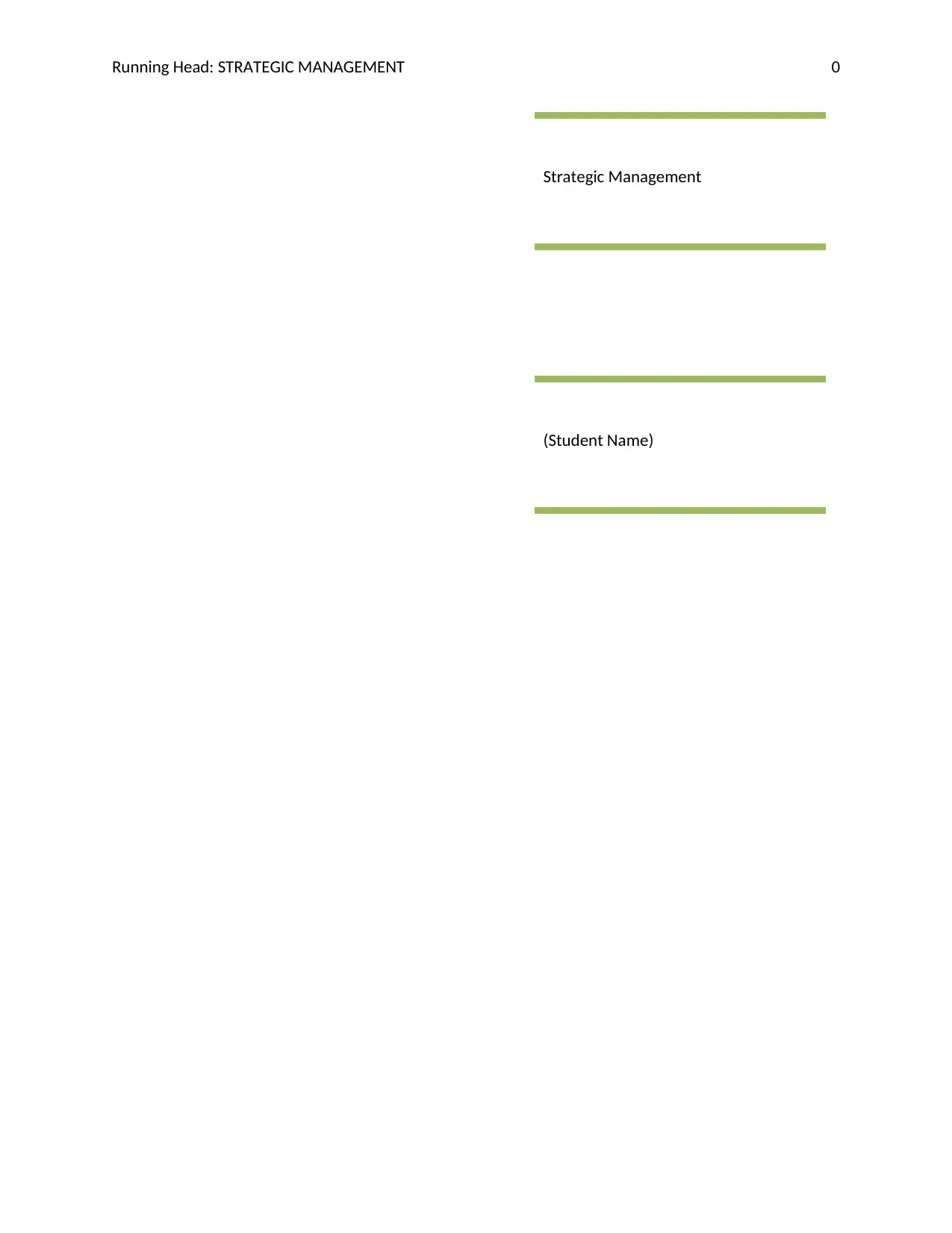
Running Head: STRATEGIC MANAGEMENT 0
Strategic Management
(Student Name)
Strategic Management
(Student Name)
Paraphrase This Document
Need a fresh take? Get an instant paraphrase of this document with our AI Paraphraser
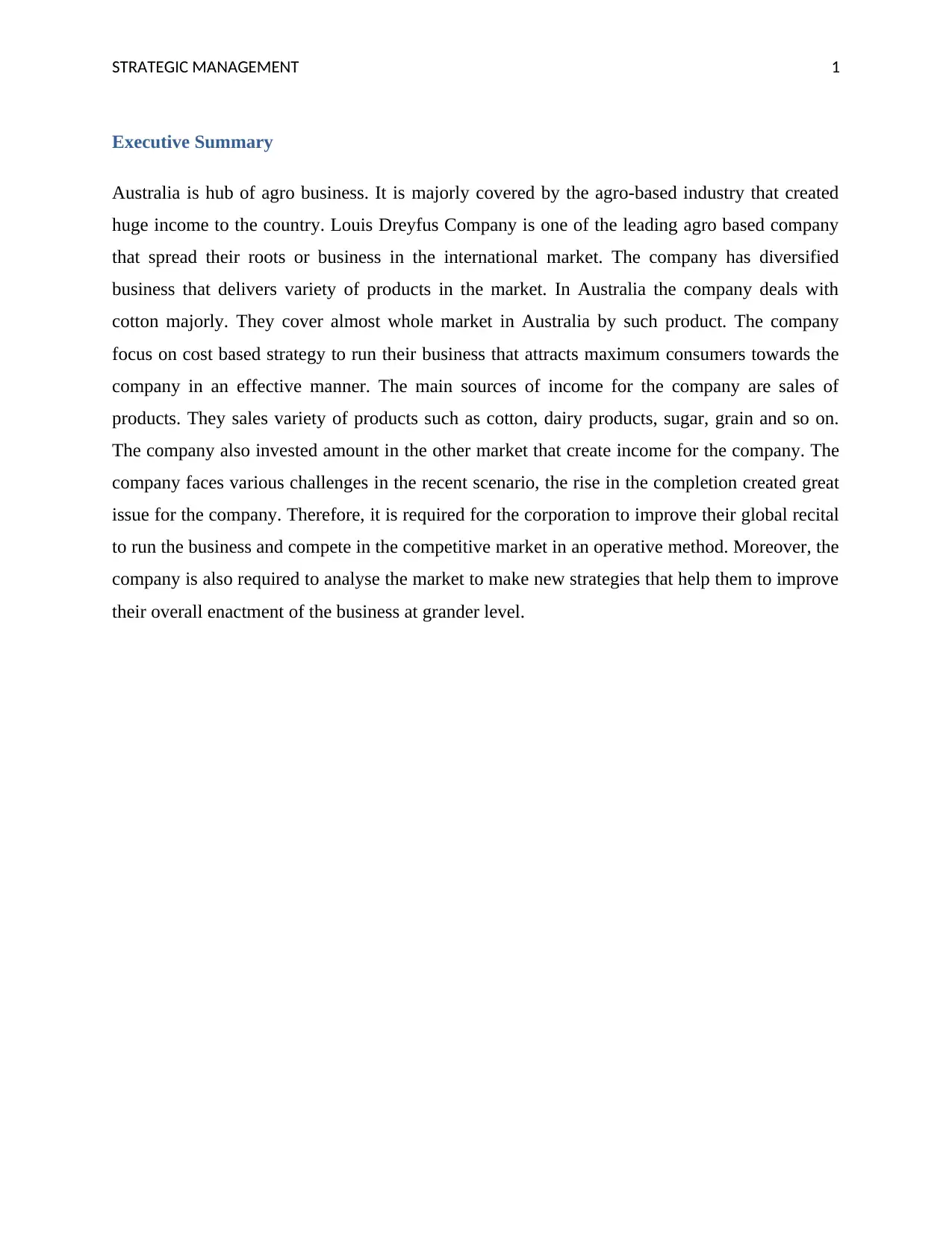
STRATEGIC MANAGEMENT 1
Executive Summary
Australia is hub of agro business. It is majorly covered by the agro-based industry that created
huge income to the country. Louis Dreyfus Company is one of the leading agro based company
that spread their roots or business in the international market. The company has diversified
business that delivers variety of products in the market. In Australia the company deals with
cotton majorly. They cover almost whole market in Australia by such product. The company
focus on cost based strategy to run their business that attracts maximum consumers towards the
company in an effective manner. The main sources of income for the company are sales of
products. They sales variety of products such as cotton, dairy products, sugar, grain and so on.
The company also invested amount in the other market that create income for the company. The
company faces various challenges in the recent scenario, the rise in the completion created great
issue for the company. Therefore, it is required for the corporation to improve their global recital
to run the business and compete in the competitive market in an operative method. Moreover, the
company is also required to analyse the market to make new strategies that help them to improve
their overall enactment of the business at grander level.
Executive Summary
Australia is hub of agro business. It is majorly covered by the agro-based industry that created
huge income to the country. Louis Dreyfus Company is one of the leading agro based company
that spread their roots or business in the international market. The company has diversified
business that delivers variety of products in the market. In Australia the company deals with
cotton majorly. They cover almost whole market in Australia by such product. The company
focus on cost based strategy to run their business that attracts maximum consumers towards the
company in an effective manner. The main sources of income for the company are sales of
products. They sales variety of products such as cotton, dairy products, sugar, grain and so on.
The company also invested amount in the other market that create income for the company. The
company faces various challenges in the recent scenario, the rise in the completion created great
issue for the company. Therefore, it is required for the corporation to improve their global recital
to run the business and compete in the competitive market in an operative method. Moreover, the
company is also required to analyse the market to make new strategies that help them to improve
their overall enactment of the business at grander level.
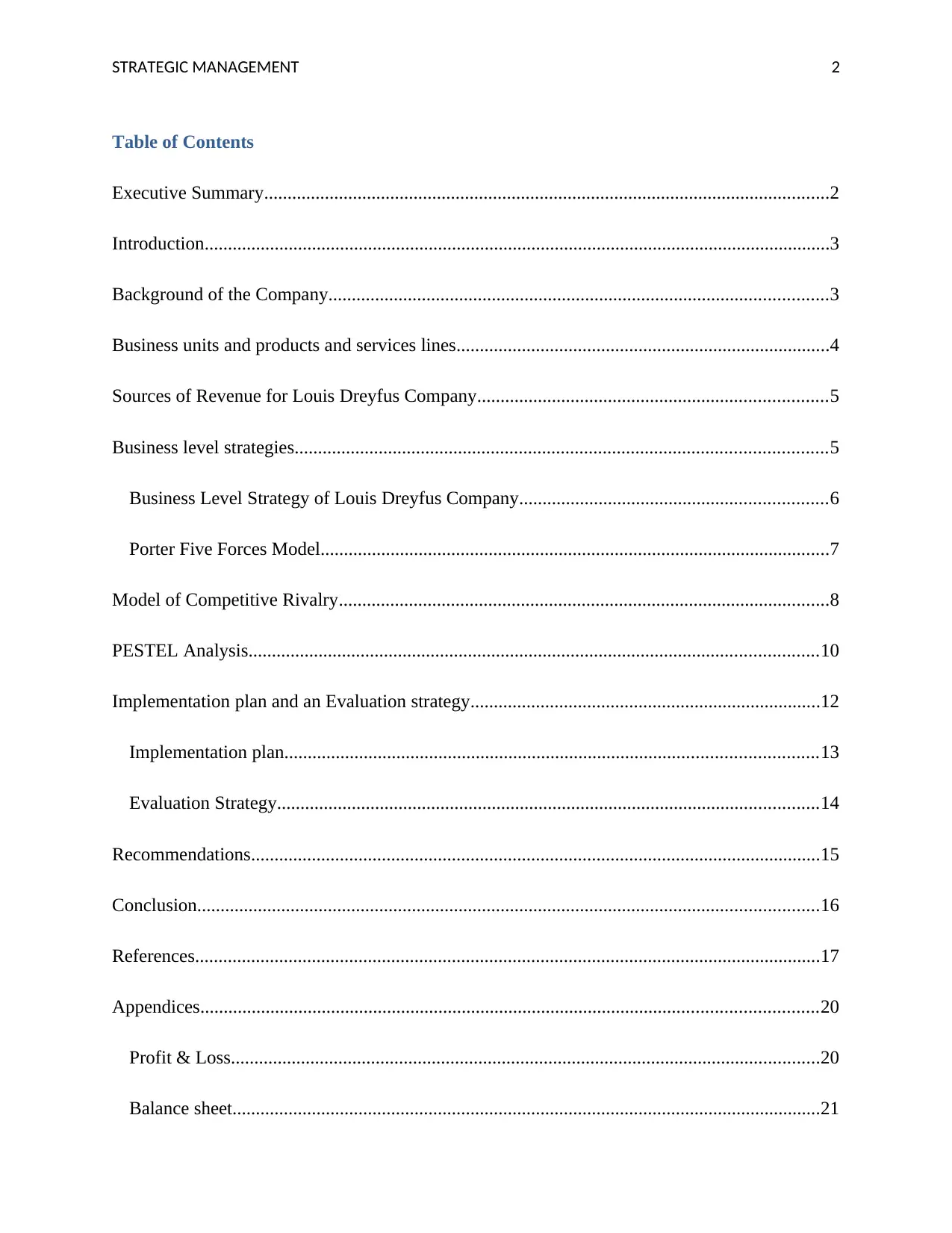
STRATEGIC MANAGEMENT 2
Table of Contents
Executive Summary.........................................................................................................................2
Introduction......................................................................................................................................3
Background of the Company...........................................................................................................3
Business units and products and services lines................................................................................4
Sources of Revenue for Louis Dreyfus Company...........................................................................5
Business level strategies..................................................................................................................5
Business Level Strategy of Louis Dreyfus Company..................................................................6
Porter Five Forces Model.............................................................................................................7
Model of Competitive Rivalry.........................................................................................................8
PESTEL Analysis..........................................................................................................................10
Implementation plan and an Evaluation strategy...........................................................................12
Implementation plan..................................................................................................................13
Evaluation Strategy....................................................................................................................14
Recommendations..........................................................................................................................15
Conclusion.....................................................................................................................................16
References......................................................................................................................................17
Appendices....................................................................................................................................20
Profit & Loss..............................................................................................................................20
Balance sheet..............................................................................................................................21
Table of Contents
Executive Summary.........................................................................................................................2
Introduction......................................................................................................................................3
Background of the Company...........................................................................................................3
Business units and products and services lines................................................................................4
Sources of Revenue for Louis Dreyfus Company...........................................................................5
Business level strategies..................................................................................................................5
Business Level Strategy of Louis Dreyfus Company..................................................................6
Porter Five Forces Model.............................................................................................................7
Model of Competitive Rivalry.........................................................................................................8
PESTEL Analysis..........................................................................................................................10
Implementation plan and an Evaluation strategy...........................................................................12
Implementation plan..................................................................................................................13
Evaluation Strategy....................................................................................................................14
Recommendations..........................................................................................................................15
Conclusion.....................................................................................................................................16
References......................................................................................................................................17
Appendices....................................................................................................................................20
Profit & Loss..............................................................................................................................20
Balance sheet..............................................................................................................................21
⊘ This is a preview!⊘
Do you want full access?
Subscribe today to unlock all pages.

Trusted by 1+ million students worldwide
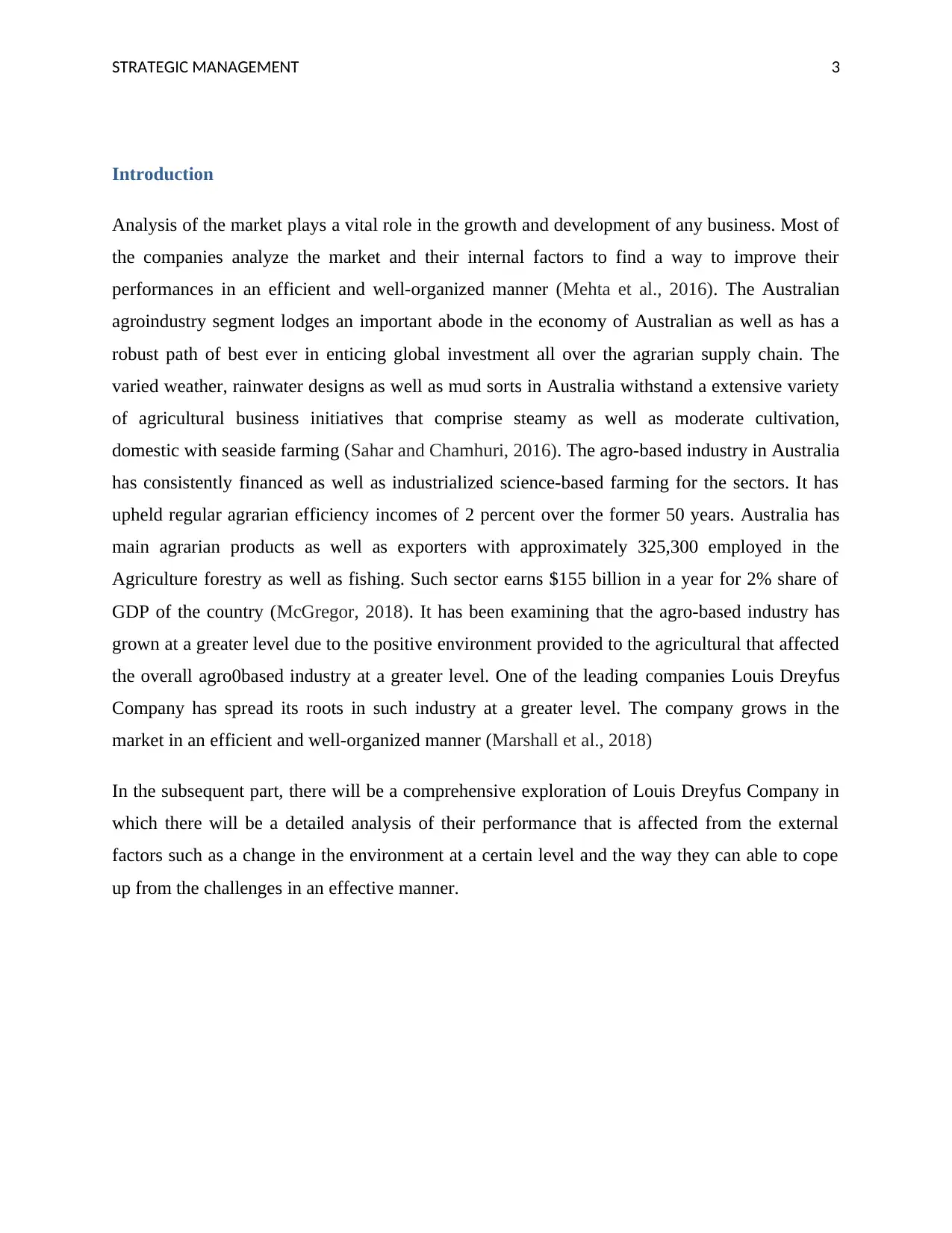
STRATEGIC MANAGEMENT 3
Introduction
Analysis of the market plays a vital role in the growth and development of any business. Most of
the companies analyze the market and their internal factors to find a way to improve their
performances in an efficient and well-organized manner (Mehta et al., 2016). The Australian
agroindustry segment lodges an important abode in the economy of Australian as well as has a
robust path of best ever in enticing global investment all over the agrarian supply chain. The
varied weather, rainwater designs as well as mud sorts in Australia withstand a extensive variety
of agricultural business initiatives that comprise steamy as well as moderate cultivation,
domestic with seaside farming (Sahar and Chamhuri, 2016). The agro-based industry in Australia
has consistently financed as well as industrialized science-based farming for the sectors. It has
upheld regular agrarian efficiency incomes of 2 percent over the former 50 years. Australia has
main agrarian products as well as exporters with approximately 325,300 employed in the
Agriculture forestry as well as fishing. Such sector earns $155 billion in a year for 2% share of
GDP of the country (McGregor, 2018). It has been examining that the agro-based industry has
grown at a greater level due to the positive environment provided to the agricultural that affected
the overall agro0based industry at a greater level. One of the leading companies Louis Dreyfus
Company has spread its roots in such industry at a greater level. The company grows in the
market in an efficient and well-organized manner (Marshall et al., 2018)
In the subsequent part, there will be a comprehensive exploration of Louis Dreyfus Company in
which there will be a detailed analysis of their performance that is affected from the external
factors such as a change in the environment at a certain level and the way they can able to cope
up from the challenges in an effective manner.
Introduction
Analysis of the market plays a vital role in the growth and development of any business. Most of
the companies analyze the market and their internal factors to find a way to improve their
performances in an efficient and well-organized manner (Mehta et al., 2016). The Australian
agroindustry segment lodges an important abode in the economy of Australian as well as has a
robust path of best ever in enticing global investment all over the agrarian supply chain. The
varied weather, rainwater designs as well as mud sorts in Australia withstand a extensive variety
of agricultural business initiatives that comprise steamy as well as moderate cultivation,
domestic with seaside farming (Sahar and Chamhuri, 2016). The agro-based industry in Australia
has consistently financed as well as industrialized science-based farming for the sectors. It has
upheld regular agrarian efficiency incomes of 2 percent over the former 50 years. Australia has
main agrarian products as well as exporters with approximately 325,300 employed in the
Agriculture forestry as well as fishing. Such sector earns $155 billion in a year for 2% share of
GDP of the country (McGregor, 2018). It has been examining that the agro-based industry has
grown at a greater level due to the positive environment provided to the agricultural that affected
the overall agro0based industry at a greater level. One of the leading companies Louis Dreyfus
Company has spread its roots in such industry at a greater level. The company grows in the
market in an efficient and well-organized manner (Marshall et al., 2018)
In the subsequent part, there will be a comprehensive exploration of Louis Dreyfus Company in
which there will be a detailed analysis of their performance that is affected from the external
factors such as a change in the environment at a certain level and the way they can able to cope
up from the challenges in an effective manner.
Paraphrase This Document
Need a fresh take? Get an instant paraphrase of this document with our AI Paraphraser
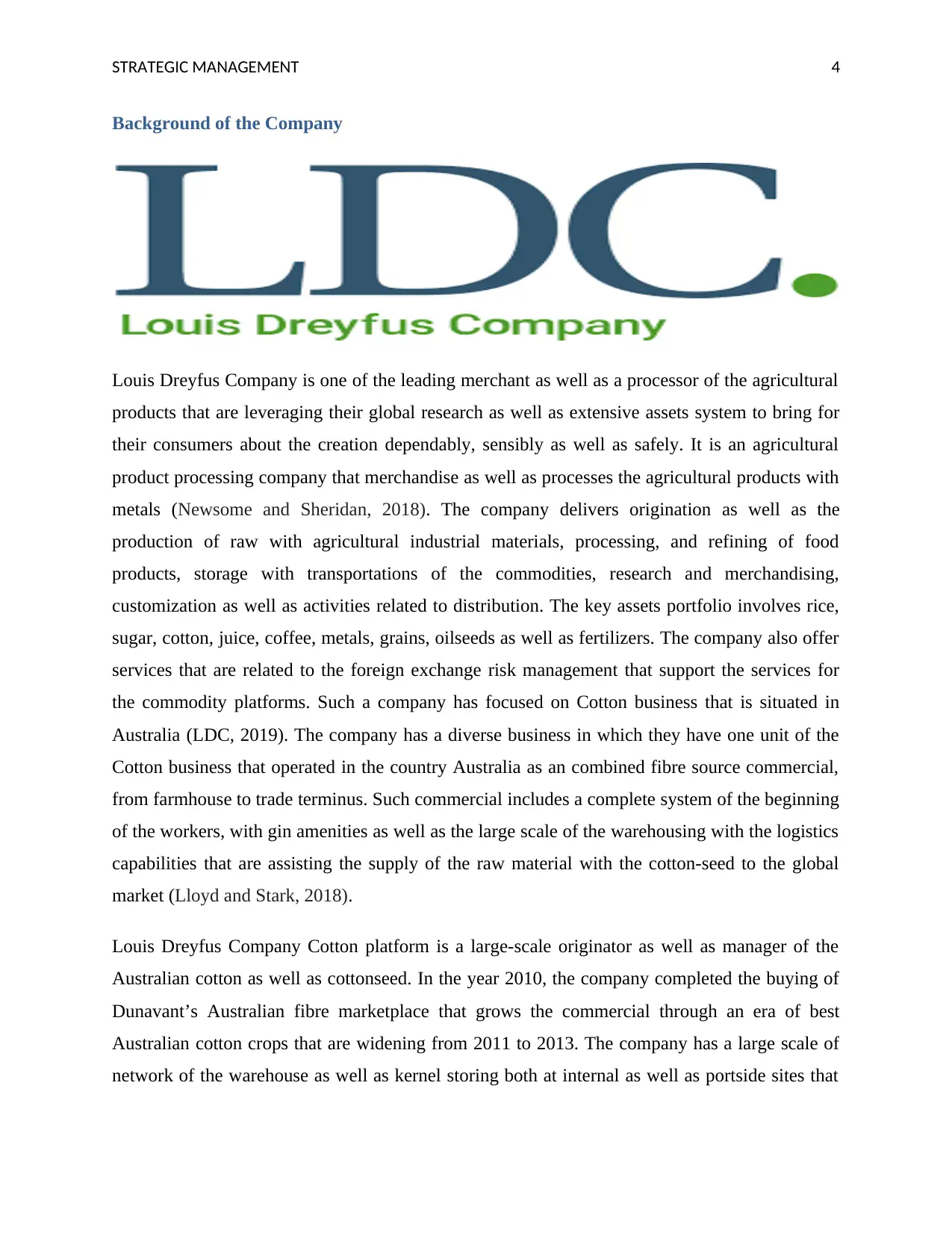
STRATEGIC MANAGEMENT 4
Background of the Company
Louis Dreyfus Company is one of the leading merchant as well as a processor of the agricultural
products that are leveraging their global research as well as extensive assets system to bring for
their consumers about the creation dependably, sensibly as well as safely. It is an agricultural
product processing company that merchandise as well as processes the agricultural products with
metals (Newsome and Sheridan, 2018). The company delivers origination as well as the
production of raw with agricultural industrial materials, processing, and refining of food
products, storage with transportations of the commodities, research and merchandising,
customization as well as activities related to distribution. The key assets portfolio involves rice,
sugar, cotton, juice, coffee, metals, grains, oilseeds as well as fertilizers. The company also offer
services that are related to the foreign exchange risk management that support the services for
the commodity platforms. Such a company has focused on Cotton business that is situated in
Australia (LDC, 2019). The company has a diverse business in which they have one unit of the
Cotton business that operated in the country Australia as an combined fibre source commercial,
from farmhouse to trade terminus. Such commercial includes a complete system of the beginning
of the workers, with gin amenities as well as the large scale of the warehousing with the logistics
capabilities that are assisting the supply of the raw material with the cotton-seed to the global
market (Lloyd and Stark, 2018).
Louis Dreyfus Company Cotton platform is a large-scale originator as well as manager of the
Australian cotton as well as cottonseed. In the year 2010, the company completed the buying of
Dunavant’s Australian fibre marketplace that grows the commercial through an era of best
Australian cotton crops that are widening from 2011 to 2013. The company has a large scale of
network of the warehouse as well as kernel storing both at internal as well as portside sites that
Background of the Company
Louis Dreyfus Company is one of the leading merchant as well as a processor of the agricultural
products that are leveraging their global research as well as extensive assets system to bring for
their consumers about the creation dependably, sensibly as well as safely. It is an agricultural
product processing company that merchandise as well as processes the agricultural products with
metals (Newsome and Sheridan, 2018). The company delivers origination as well as the
production of raw with agricultural industrial materials, processing, and refining of food
products, storage with transportations of the commodities, research and merchandising,
customization as well as activities related to distribution. The key assets portfolio involves rice,
sugar, cotton, juice, coffee, metals, grains, oilseeds as well as fertilizers. The company also offer
services that are related to the foreign exchange risk management that support the services for
the commodity platforms. Such a company has focused on Cotton business that is situated in
Australia (LDC, 2019). The company has a diverse business in which they have one unit of the
Cotton business that operated in the country Australia as an combined fibre source commercial,
from farmhouse to trade terminus. Such commercial includes a complete system of the beginning
of the workers, with gin amenities as well as the large scale of the warehousing with the logistics
capabilities that are assisting the supply of the raw material with the cotton-seed to the global
market (Lloyd and Stark, 2018).
Louis Dreyfus Company Cotton platform is a large-scale originator as well as manager of the
Australian cotton as well as cottonseed. In the year 2010, the company completed the buying of
Dunavant’s Australian fibre marketplace that grows the commercial through an era of best
Australian cotton crops that are widening from 2011 to 2013. The company has a large scale of
network of the warehouse as well as kernel storing both at internal as well as portside sites that
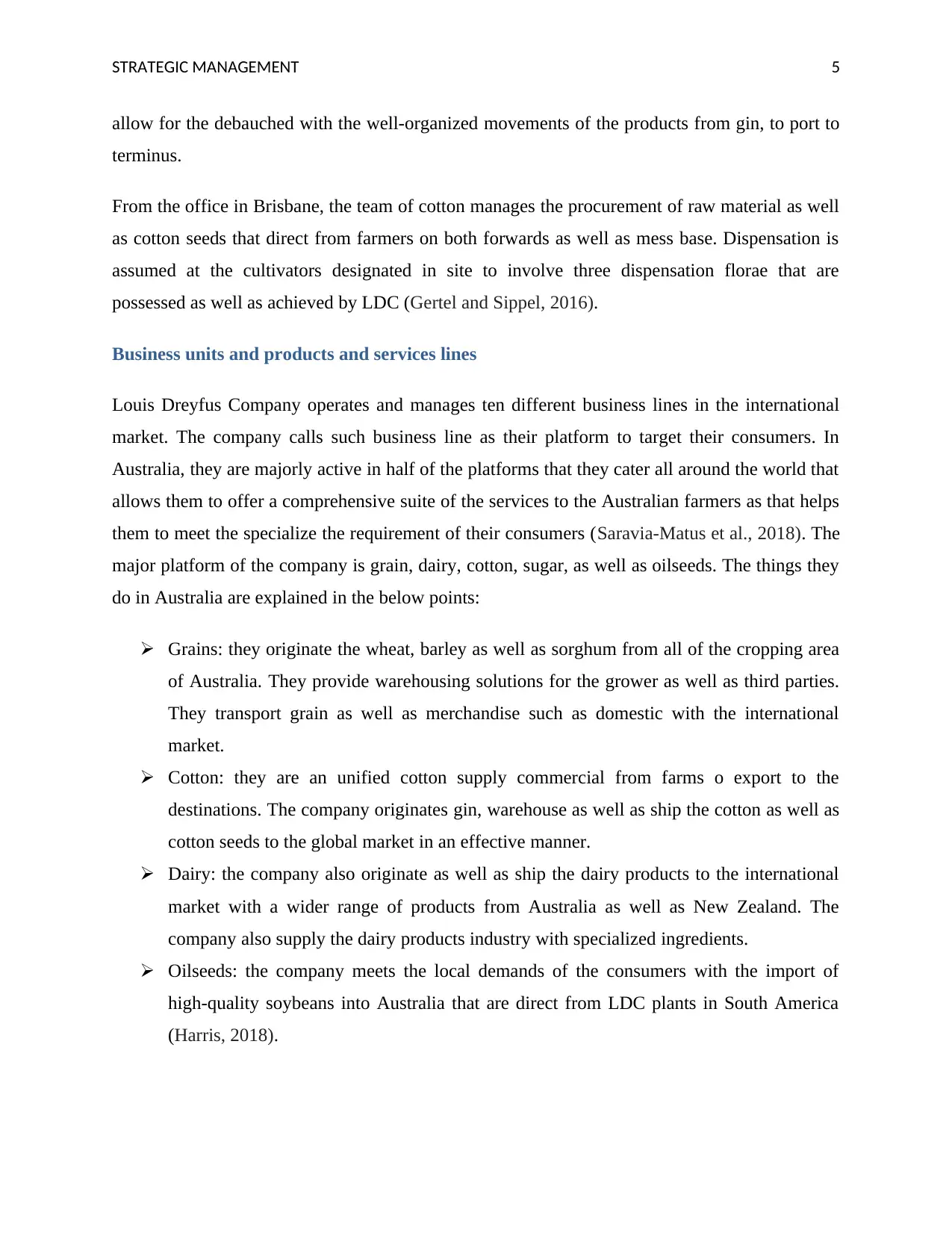
STRATEGIC MANAGEMENT 5
allow for the debauched with the well-organized movements of the products from gin, to port to
terminus.
From the office in Brisbane, the team of cotton manages the procurement of raw material as well
as cotton seeds that direct from farmers on both forwards as well as mess base. Dispensation is
assumed at the cultivators designated in site to involve three dispensation florae that are
possessed as well as achieved by LDC (Gertel and Sippel, 2016).
Business units and products and services lines
Louis Dreyfus Company operates and manages ten different business lines in the international
market. The company calls such business line as their platform to target their consumers. In
Australia, they are majorly active in half of the platforms that they cater all around the world that
allows them to offer a comprehensive suite of the services to the Australian farmers as that helps
them to meet the specialize the requirement of their consumers (Saravia-Matus et al., 2018). The
major platform of the company is grain, dairy, cotton, sugar, as well as oilseeds. The things they
do in Australia are explained in the below points:
Grains: they originate the wheat, barley as well as sorghum from all of the cropping area
of Australia. They provide warehousing solutions for the grower as well as third parties.
They transport grain as well as merchandise such as domestic with the international
market.
Cotton: they are an unified cotton supply commercial from farms o export to the
destinations. The company originates gin, warehouse as well as ship the cotton as well as
cotton seeds to the global market in an effective manner.
Dairy: the company also originate as well as ship the dairy products to the international
market with a wider range of products from Australia as well as New Zealand. The
company also supply the dairy products industry with specialized ingredients.
Oilseeds: the company meets the local demands of the consumers with the import of
high-quality soybeans into Australia that are direct from LDC plants in South America
(Harris, 2018).
allow for the debauched with the well-organized movements of the products from gin, to port to
terminus.
From the office in Brisbane, the team of cotton manages the procurement of raw material as well
as cotton seeds that direct from farmers on both forwards as well as mess base. Dispensation is
assumed at the cultivators designated in site to involve three dispensation florae that are
possessed as well as achieved by LDC (Gertel and Sippel, 2016).
Business units and products and services lines
Louis Dreyfus Company operates and manages ten different business lines in the international
market. The company calls such business line as their platform to target their consumers. In
Australia, they are majorly active in half of the platforms that they cater all around the world that
allows them to offer a comprehensive suite of the services to the Australian farmers as that helps
them to meet the specialize the requirement of their consumers (Saravia-Matus et al., 2018). The
major platform of the company is grain, dairy, cotton, sugar, as well as oilseeds. The things they
do in Australia are explained in the below points:
Grains: they originate the wheat, barley as well as sorghum from all of the cropping area
of Australia. They provide warehousing solutions for the grower as well as third parties.
They transport grain as well as merchandise such as domestic with the international
market.
Cotton: they are an unified cotton supply commercial from farms o export to the
destinations. The company originates gin, warehouse as well as ship the cotton as well as
cotton seeds to the global market in an effective manner.
Dairy: the company also originate as well as ship the dairy products to the international
market with a wider range of products from Australia as well as New Zealand. The
company also supply the dairy products industry with specialized ingredients.
Oilseeds: the company meets the local demands of the consumers with the import of
high-quality soybeans into Australia that are direct from LDC plants in South America
(Harris, 2018).
⊘ This is a preview!⊘
Do you want full access?
Subscribe today to unlock all pages.

Trusted by 1+ million students worldwide
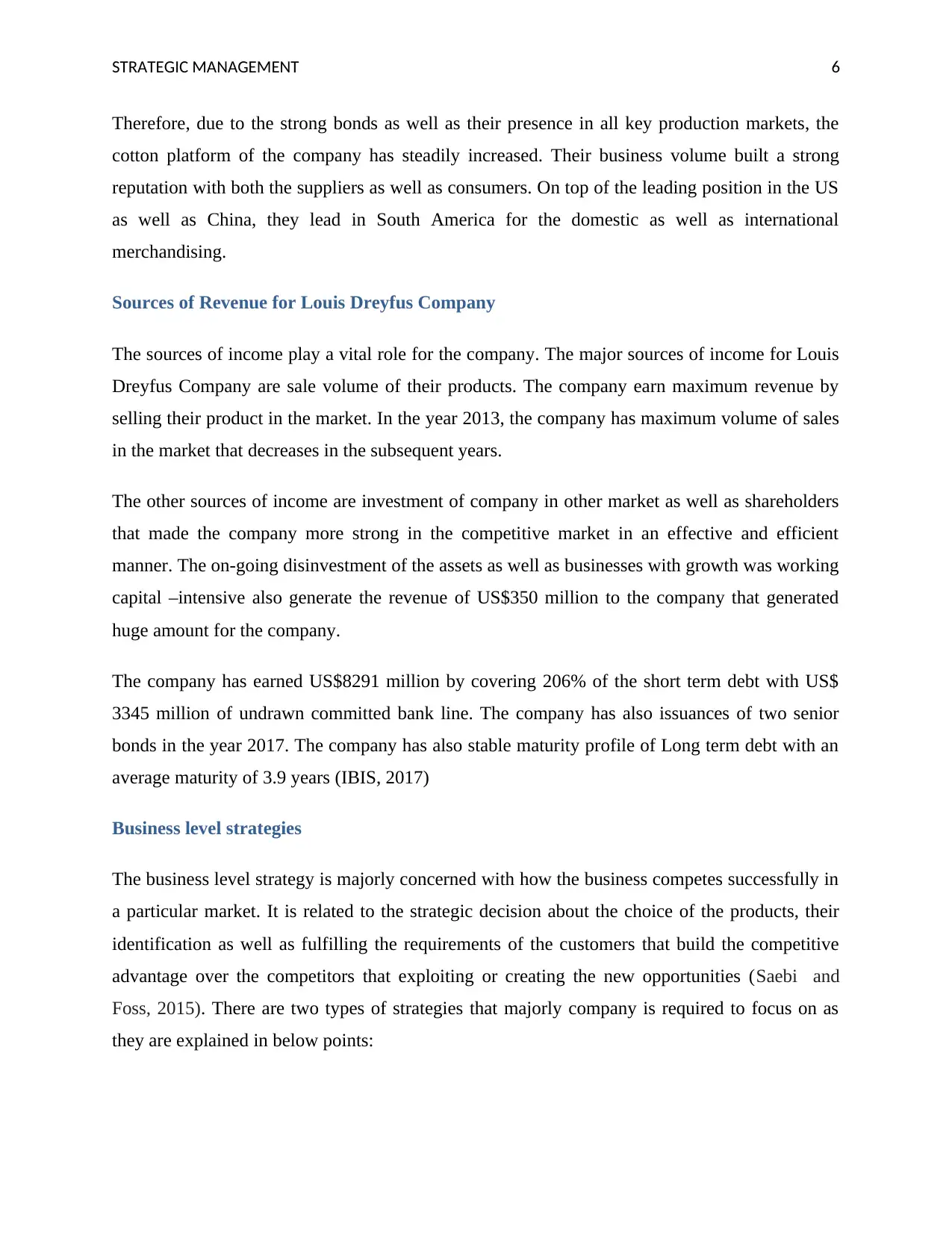
STRATEGIC MANAGEMENT 6
Therefore, due to the strong bonds as well as their presence in all key production markets, the
cotton platform of the company has steadily increased. Their business volume built a strong
reputation with both the suppliers as well as consumers. On top of the leading position in the US
as well as China, they lead in South America for the domestic as well as international
merchandising.
Sources of Revenue for Louis Dreyfus Company
The sources of income play a vital role for the company. The major sources of income for Louis
Dreyfus Company are sale volume of their products. The company earn maximum revenue by
selling their product in the market. In the year 2013, the company has maximum volume of sales
in the market that decreases in the subsequent years.
The other sources of income are investment of company in other market as well as shareholders
that made the company more strong in the competitive market in an effective and efficient
manner. The on-going disinvestment of the assets as well as businesses with growth was working
capital –intensive also generate the revenue of US$350 million to the company that generated
huge amount for the company.
The company has earned US$8291 million by covering 206% of the short term debt with US$
3345 million of undrawn committed bank line. The company has also issuances of two senior
bonds in the year 2017. The company has also stable maturity profile of Long term debt with an
average maturity of 3.9 years (IBIS, 2017)
Business level strategies
The business level strategy is majorly concerned with how the business competes successfully in
a particular market. It is related to the strategic decision about the choice of the products, their
identification as well as fulfilling the requirements of the customers that build the competitive
advantage over the competitors that exploiting or creating the new opportunities (Saebi and
Foss, 2015). There are two types of strategies that majorly company is required to focus on as
they are explained in below points:
Therefore, due to the strong bonds as well as their presence in all key production markets, the
cotton platform of the company has steadily increased. Their business volume built a strong
reputation with both the suppliers as well as consumers. On top of the leading position in the US
as well as China, they lead in South America for the domestic as well as international
merchandising.
Sources of Revenue for Louis Dreyfus Company
The sources of income play a vital role for the company. The major sources of income for Louis
Dreyfus Company are sale volume of their products. The company earn maximum revenue by
selling their product in the market. In the year 2013, the company has maximum volume of sales
in the market that decreases in the subsequent years.
The other sources of income are investment of company in other market as well as shareholders
that made the company more strong in the competitive market in an effective and efficient
manner. The on-going disinvestment of the assets as well as businesses with growth was working
capital –intensive also generate the revenue of US$350 million to the company that generated
huge amount for the company.
The company has earned US$8291 million by covering 206% of the short term debt with US$
3345 million of undrawn committed bank line. The company has also issuances of two senior
bonds in the year 2017. The company has also stable maturity profile of Long term debt with an
average maturity of 3.9 years (IBIS, 2017)
Business level strategies
The business level strategy is majorly concerned with how the business competes successfully in
a particular market. It is related to the strategic decision about the choice of the products, their
identification as well as fulfilling the requirements of the customers that build the competitive
advantage over the competitors that exploiting or creating the new opportunities (Saebi and
Foss, 2015). There are two types of strategies that majorly company is required to focus on as
they are explained in below points:
Paraphrase This Document
Need a fresh take? Get an instant paraphrase of this document with our AI Paraphraser
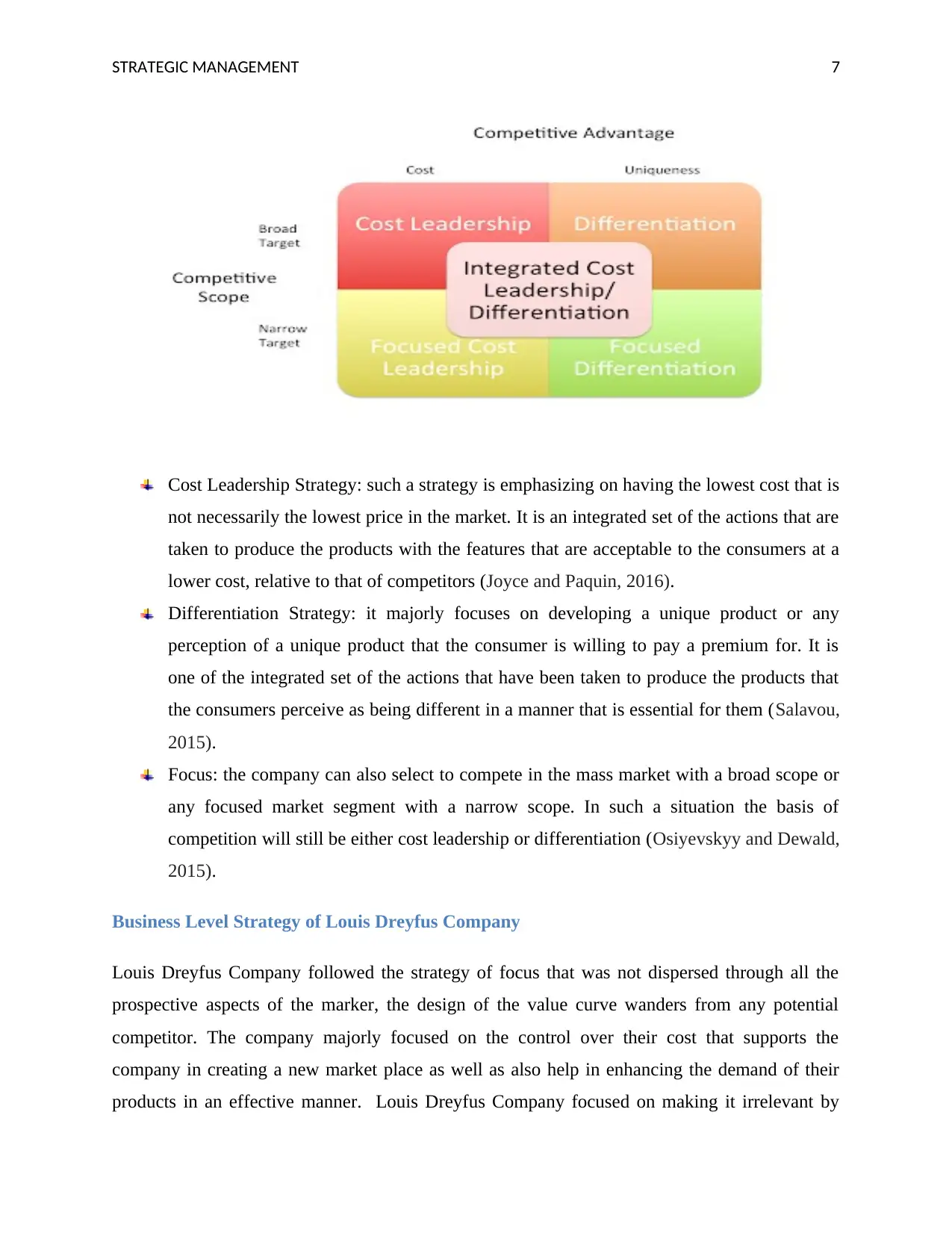
STRATEGIC MANAGEMENT 7
Cost Leadership Strategy: such a strategy is emphasizing on having the lowest cost that is
not necessarily the lowest price in the market. It is an integrated set of the actions that are
taken to produce the products with the features that are acceptable to the consumers at a
lower cost, relative to that of competitors (Joyce and Paquin, 2016).
Differentiation Strategy: it majorly focuses on developing a unique product or any
perception of a unique product that the consumer is willing to pay a premium for. It is
one of the integrated set of the actions that have been taken to produce the products that
the consumers perceive as being different in a manner that is essential for them (Salavou,
2015).
Focus: the company can also select to compete in the mass market with a broad scope or
any focused market segment with a narrow scope. In such a situation the basis of
competition will still be either cost leadership or differentiation (Osiyevskyy and Dewald,
2015).
Business Level Strategy of Louis Dreyfus Company
Louis Dreyfus Company followed the strategy of focus that was not dispersed through all the
prospective aspects of the marker, the design of the value curve wanders from any potential
competitor. The company majorly focused on the control over their cost that supports the
company in creating a new market place as well as also help in enhancing the demand of their
products in an effective manner. Louis Dreyfus Company focused on making it irrelevant by
Cost Leadership Strategy: such a strategy is emphasizing on having the lowest cost that is
not necessarily the lowest price in the market. It is an integrated set of the actions that are
taken to produce the products with the features that are acceptable to the consumers at a
lower cost, relative to that of competitors (Joyce and Paquin, 2016).
Differentiation Strategy: it majorly focuses on developing a unique product or any
perception of a unique product that the consumer is willing to pay a premium for. It is
one of the integrated set of the actions that have been taken to produce the products that
the consumers perceive as being different in a manner that is essential for them (Salavou,
2015).
Focus: the company can also select to compete in the mass market with a broad scope or
any focused market segment with a narrow scope. In such a situation the basis of
competition will still be either cost leadership or differentiation (Osiyevskyy and Dewald,
2015).
Business Level Strategy of Louis Dreyfus Company
Louis Dreyfus Company followed the strategy of focus that was not dispersed through all the
prospective aspects of the marker, the design of the value curve wanders from any potential
competitor. The company majorly focused on the control over their cost that supports the
company in creating a new market place as well as also help in enhancing the demand of their
products in an effective manner. Louis Dreyfus Company focused on making it irrelevant by
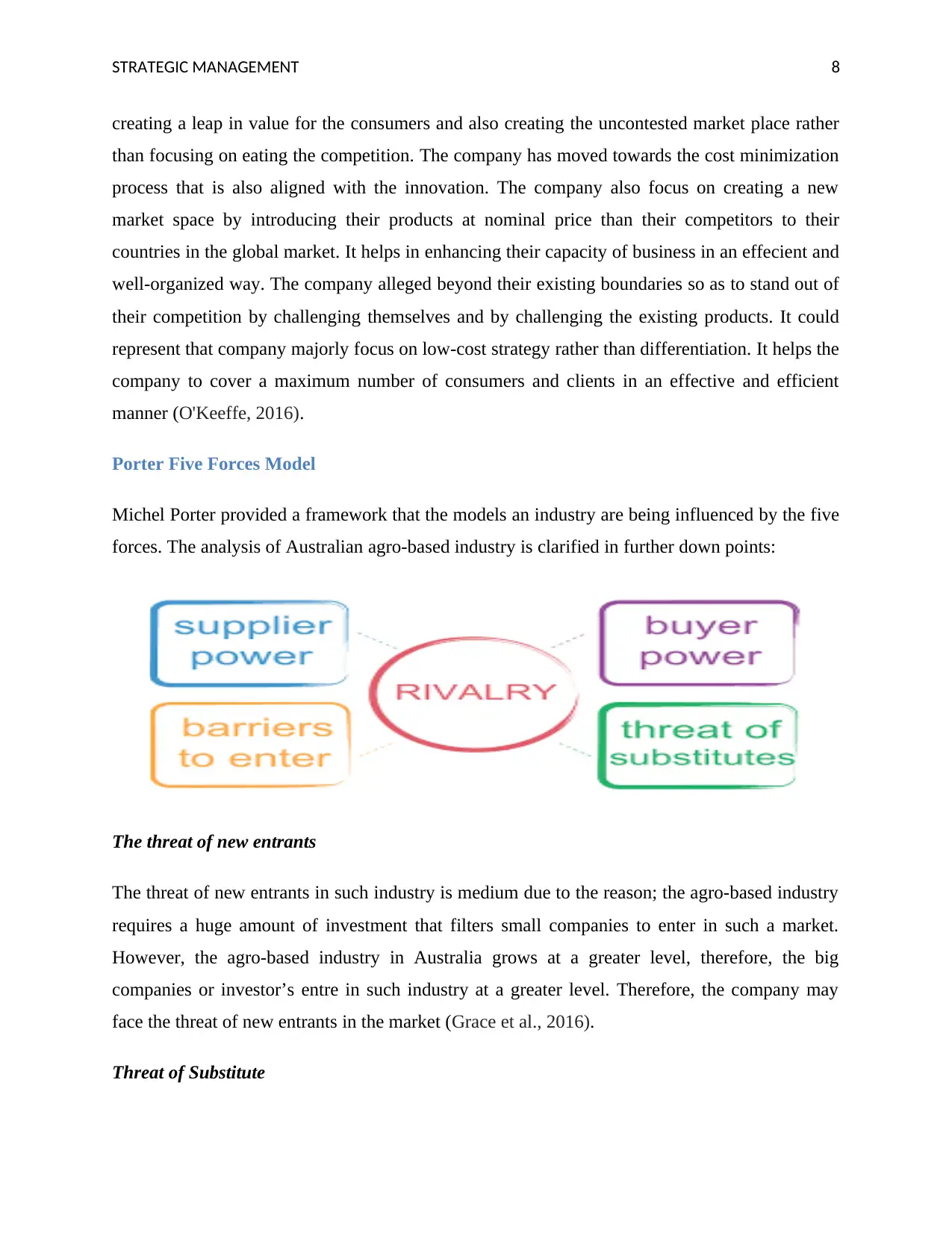
STRATEGIC MANAGEMENT 8
creating a leap in value for the consumers and also creating the uncontested market place rather
than focusing on eating the competition. The company has moved towards the cost minimization
process that is also aligned with the innovation. The company also focus on creating a new
market space by introducing their products at nominal price than their competitors to their
countries in the global market. It helps in enhancing their capacity of business in an effecient and
well-organized way. The company alleged beyond their existing boundaries so as to stand out of
their competition by challenging themselves and by challenging the existing products. It could
represent that company majorly focus on low-cost strategy rather than differentiation. It helps the
company to cover a maximum number of consumers and clients in an effective and efficient
manner (O'Keeffe, 2016).
Porter Five Forces Model
Michel Porter provided a framework that the models an industry are being influenced by the five
forces. The analysis of Australian agro-based industry is clarified in further down points:
The threat of new entrants
The threat of new entrants in such industry is medium due to the reason; the agro-based industry
requires a huge amount of investment that filters small companies to enter in such a market.
However, the agro-based industry in Australia grows at a greater level, therefore, the big
companies or investor’s entre in such industry at a greater level. Therefore, the company may
face the threat of new entrants in the market (Grace et al., 2016).
Threat of Substitute
creating a leap in value for the consumers and also creating the uncontested market place rather
than focusing on eating the competition. The company has moved towards the cost minimization
process that is also aligned with the innovation. The company also focus on creating a new
market space by introducing their products at nominal price than their competitors to their
countries in the global market. It helps in enhancing their capacity of business in an effecient and
well-organized way. The company alleged beyond their existing boundaries so as to stand out of
their competition by challenging themselves and by challenging the existing products. It could
represent that company majorly focus on low-cost strategy rather than differentiation. It helps the
company to cover a maximum number of consumers and clients in an effective and efficient
manner (O'Keeffe, 2016).
Porter Five Forces Model
Michel Porter provided a framework that the models an industry are being influenced by the five
forces. The analysis of Australian agro-based industry is clarified in further down points:
The threat of new entrants
The threat of new entrants in such industry is medium due to the reason; the agro-based industry
requires a huge amount of investment that filters small companies to enter in such a market.
However, the agro-based industry in Australia grows at a greater level, therefore, the big
companies or investor’s entre in such industry at a greater level. Therefore, the company may
face the threat of new entrants in the market (Grace et al., 2016).
Threat of Substitute
⊘ This is a preview!⊘
Do you want full access?
Subscribe today to unlock all pages.

Trusted by 1+ million students worldwide
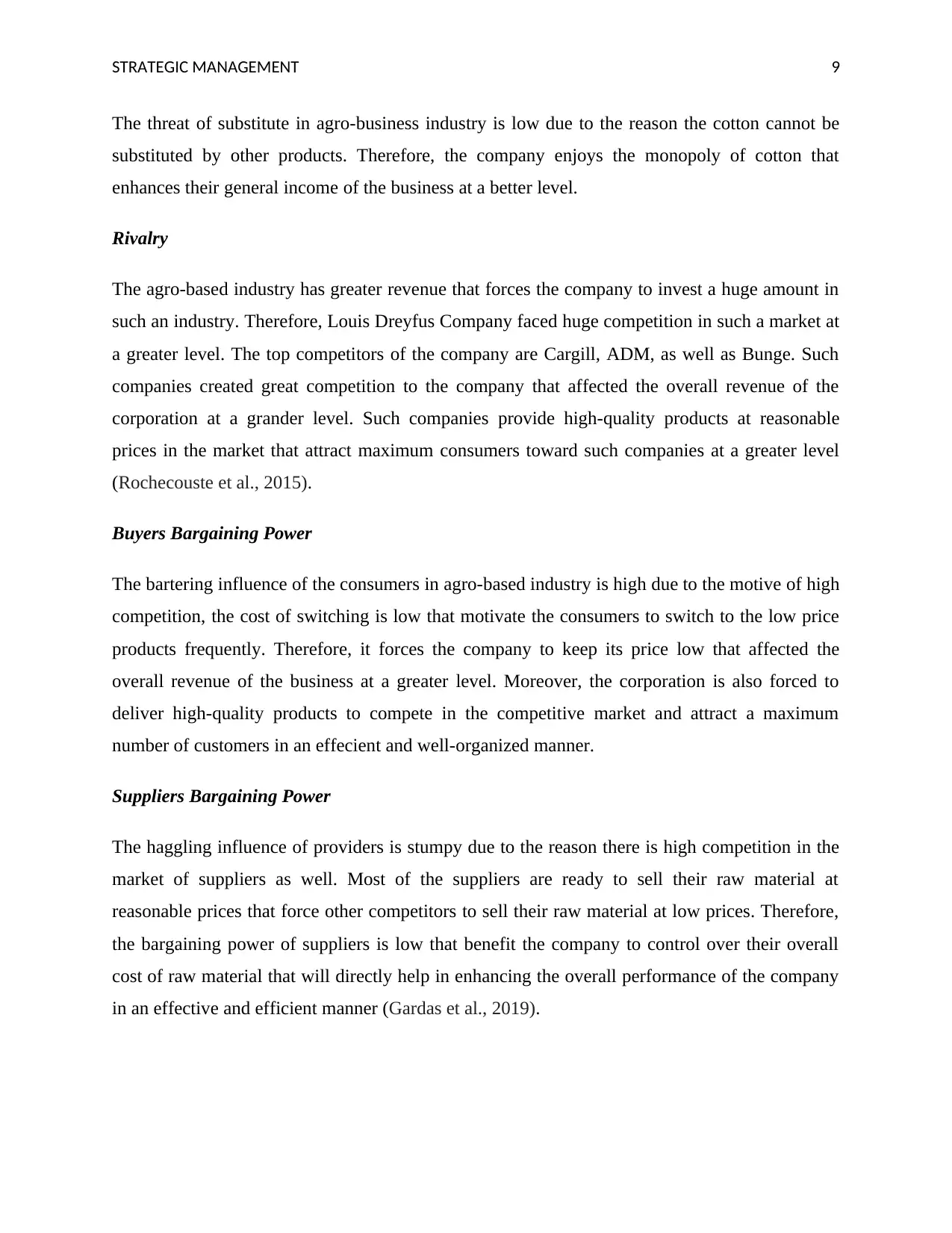
STRATEGIC MANAGEMENT 9
The threat of substitute in agro-business industry is low due to the reason the cotton cannot be
substituted by other products. Therefore, the company enjoys the monopoly of cotton that
enhances their general income of the business at a better level.
Rivalry
The agro-based industry has greater revenue that forces the company to invest a huge amount in
such an industry. Therefore, Louis Dreyfus Company faced huge competition in such a market at
a greater level. The top competitors of the company are Cargill, ADM, as well as Bunge. Such
companies created great competition to the company that affected the overall revenue of the
corporation at a grander level. Such companies provide high-quality products at reasonable
prices in the market that attract maximum consumers toward such companies at a greater level
(Rochecouste et al., 2015).
Buyers Bargaining Power
The bartering influence of the consumers in agro-based industry is high due to the motive of high
competition, the cost of switching is low that motivate the consumers to switch to the low price
products frequently. Therefore, it forces the company to keep its price low that affected the
overall revenue of the business at a greater level. Moreover, the corporation is also forced to
deliver high-quality products to compete in the competitive market and attract a maximum
number of customers in an effecient and well-organized manner.
Suppliers Bargaining Power
The haggling influence of providers is stumpy due to the reason there is high competition in the
market of suppliers as well. Most of the suppliers are ready to sell their raw material at
reasonable prices that force other competitors to sell their raw material at low prices. Therefore,
the bargaining power of suppliers is low that benefit the company to control over their overall
cost of raw material that will directly help in enhancing the overall performance of the company
in an effective and efficient manner (Gardas et al., 2019).
The threat of substitute in agro-business industry is low due to the reason the cotton cannot be
substituted by other products. Therefore, the company enjoys the monopoly of cotton that
enhances their general income of the business at a better level.
Rivalry
The agro-based industry has greater revenue that forces the company to invest a huge amount in
such an industry. Therefore, Louis Dreyfus Company faced huge competition in such a market at
a greater level. The top competitors of the company are Cargill, ADM, as well as Bunge. Such
companies created great competition to the company that affected the overall revenue of the
corporation at a grander level. Such companies provide high-quality products at reasonable
prices in the market that attract maximum consumers toward such companies at a greater level
(Rochecouste et al., 2015).
Buyers Bargaining Power
The bartering influence of the consumers in agro-based industry is high due to the motive of high
competition, the cost of switching is low that motivate the consumers to switch to the low price
products frequently. Therefore, it forces the company to keep its price low that affected the
overall revenue of the business at a greater level. Moreover, the corporation is also forced to
deliver high-quality products to compete in the competitive market and attract a maximum
number of customers in an effecient and well-organized manner.
Suppliers Bargaining Power
The haggling influence of providers is stumpy due to the reason there is high competition in the
market of suppliers as well. Most of the suppliers are ready to sell their raw material at
reasonable prices that force other competitors to sell their raw material at low prices. Therefore,
the bargaining power of suppliers is low that benefit the company to control over their overall
cost of raw material that will directly help in enhancing the overall performance of the company
in an effective and efficient manner (Gardas et al., 2019).
Paraphrase This Document
Need a fresh take? Get an instant paraphrase of this document with our AI Paraphraser
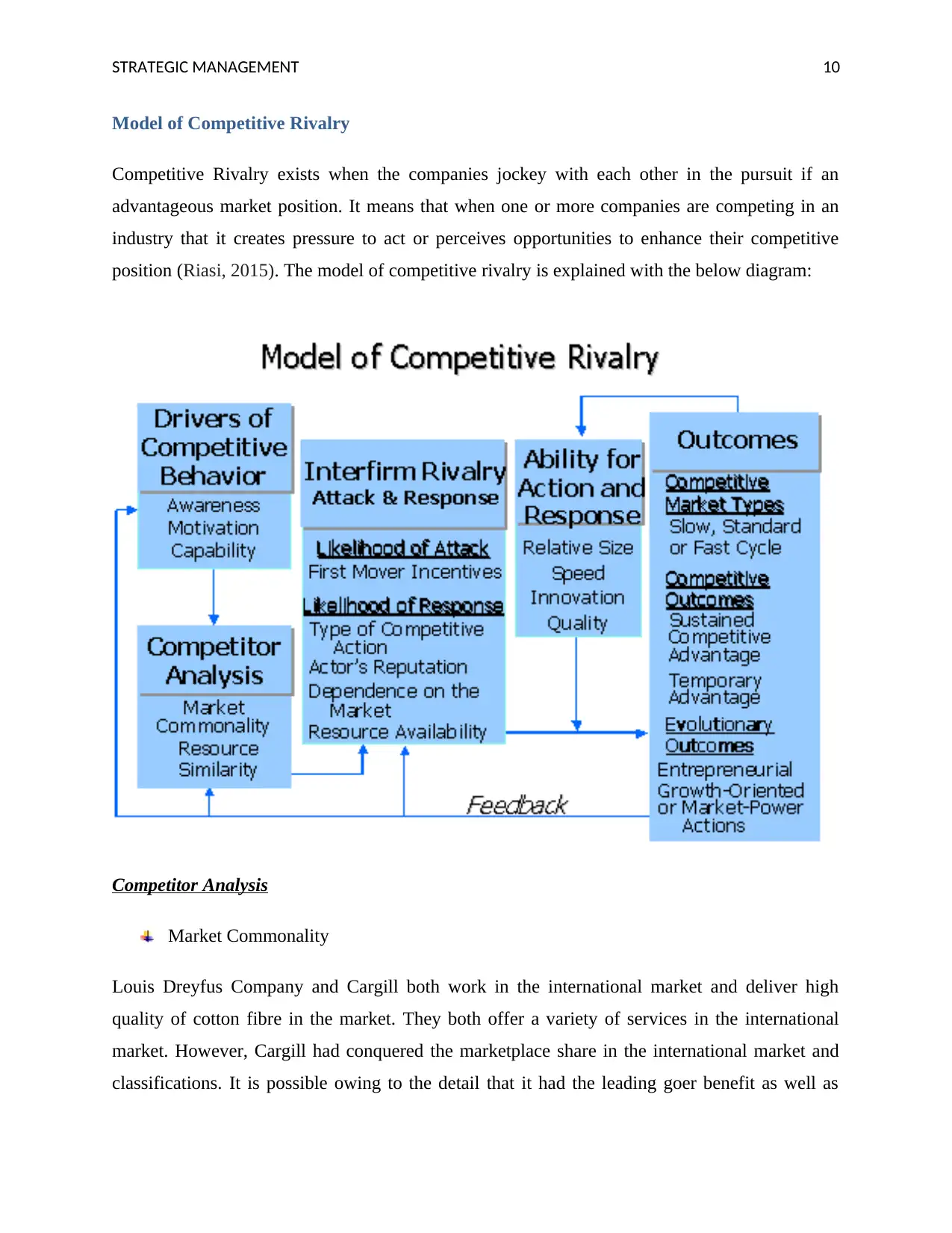
STRATEGIC MANAGEMENT 10
Model of Competitive Rivalry
Competitive Rivalry exists when the companies jockey with each other in the pursuit if an
advantageous market position. It means that when one or more companies are competing in an
industry that it creates pressure to act or perceives opportunities to enhance their competitive
position (Riasi, 2015). The model of competitive rivalry is explained with the below diagram:
Competitor Analysis
Market Commonality
Louis Dreyfus Company and Cargill both work in the international market and deliver high
quality of cotton fibre in the market. They both offer a variety of services in the international
market. However, Cargill had conquered the marketplace share in the international market and
classifications. It is possible owing to the detail that it had the leading goer benefit as well as
Model of Competitive Rivalry
Competitive Rivalry exists when the companies jockey with each other in the pursuit if an
advantageous market position. It means that when one or more companies are competing in an
industry that it creates pressure to act or perceives opportunities to enhance their competitive
position (Riasi, 2015). The model of competitive rivalry is explained with the below diagram:
Competitor Analysis
Market Commonality
Louis Dreyfus Company and Cargill both work in the international market and deliver high
quality of cotton fibre in the market. They both offer a variety of services in the international
market. However, Cargill had conquered the marketplace share in the international market and
classifications. It is possible owing to the detail that it had the leading goer benefit as well as
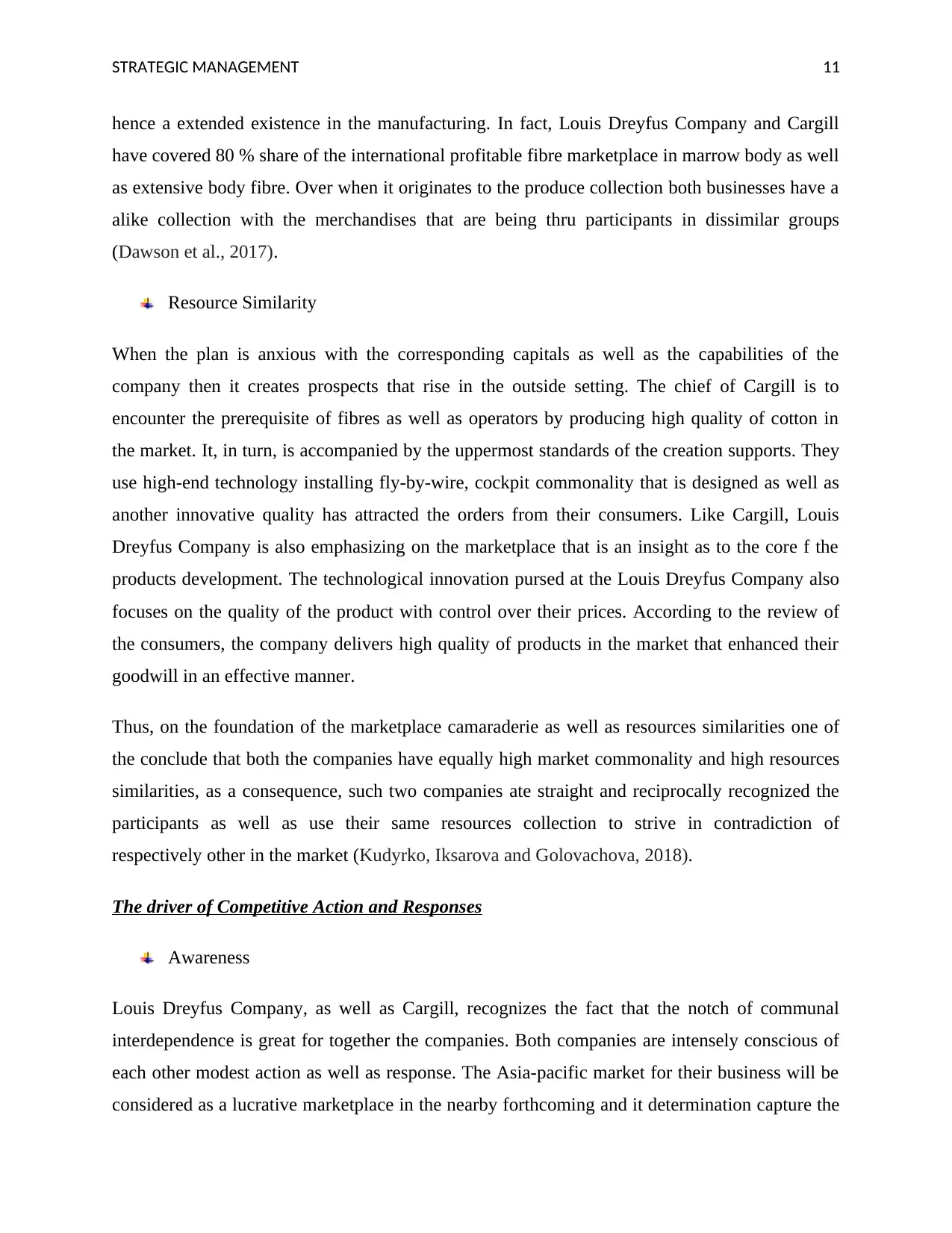
STRATEGIC MANAGEMENT 11
hence a extended existence in the manufacturing. In fact, Louis Dreyfus Company and Cargill
have covered 80 % share of the international profitable fibre marketplace in marrow body as well
as extensive body fibre. Over when it originates to the produce collection both businesses have a
alike collection with the merchandises that are being thru participants in dissimilar groups
(Dawson et al., 2017).
Resource Similarity
When the plan is anxious with the corresponding capitals as well as the capabilities of the
company then it creates prospects that rise in the outside setting. The chief of Cargill is to
encounter the prerequisite of fibres as well as operators by producing high quality of cotton in
the market. It, in turn, is accompanied by the uppermost standards of the creation supports. They
use high-end technology installing fly-by-wire, cockpit commonality that is designed as well as
another innovative quality has attracted the orders from their consumers. Like Cargill, Louis
Dreyfus Company is also emphasizing on the marketplace that is an insight as to the core f the
products development. The technological innovation pursed at the Louis Dreyfus Company also
focuses on the quality of the product with control over their prices. According to the review of
the consumers, the company delivers high quality of products in the market that enhanced their
goodwill in an effective manner.
Thus, on the foundation of the marketplace camaraderie as well as resources similarities one of
the conclude that both the companies have equally high market commonality and high resources
similarities, as a consequence, such two companies ate straight and reciprocally recognized the
participants as well as use their same resources collection to strive in contradiction of
respectively other in the market (Kudyrko, Iksarova and Golovachova, 2018).
The driver of Competitive Action and Responses
Awareness
Louis Dreyfus Company, as well as Cargill, recognizes the fact that the notch of communal
interdependence is great for together the companies. Both companies are intensely conscious of
each other modest action as well as response. The Asia-pacific market for their business will be
considered as a lucrative marketplace in the nearby forthcoming and it determination capture the
hence a extended existence in the manufacturing. In fact, Louis Dreyfus Company and Cargill
have covered 80 % share of the international profitable fibre marketplace in marrow body as well
as extensive body fibre. Over when it originates to the produce collection both businesses have a
alike collection with the merchandises that are being thru participants in dissimilar groups
(Dawson et al., 2017).
Resource Similarity
When the plan is anxious with the corresponding capitals as well as the capabilities of the
company then it creates prospects that rise in the outside setting. The chief of Cargill is to
encounter the prerequisite of fibres as well as operators by producing high quality of cotton in
the market. It, in turn, is accompanied by the uppermost standards of the creation supports. They
use high-end technology installing fly-by-wire, cockpit commonality that is designed as well as
another innovative quality has attracted the orders from their consumers. Like Cargill, Louis
Dreyfus Company is also emphasizing on the marketplace that is an insight as to the core f the
products development. The technological innovation pursed at the Louis Dreyfus Company also
focuses on the quality of the product with control over their prices. According to the review of
the consumers, the company delivers high quality of products in the market that enhanced their
goodwill in an effective manner.
Thus, on the foundation of the marketplace camaraderie as well as resources similarities one of
the conclude that both the companies have equally high market commonality and high resources
similarities, as a consequence, such two companies ate straight and reciprocally recognized the
participants as well as use their same resources collection to strive in contradiction of
respectively other in the market (Kudyrko, Iksarova and Golovachova, 2018).
The driver of Competitive Action and Responses
Awareness
Louis Dreyfus Company, as well as Cargill, recognizes the fact that the notch of communal
interdependence is great for together the companies. Both companies are intensely conscious of
each other modest action as well as response. The Asia-pacific market for their business will be
considered as a lucrative marketplace in the nearby forthcoming and it determination capture the
⊘ This is a preview!⊘
Do you want full access?
Subscribe today to unlock all pages.

Trusted by 1+ million students worldwide
1 out of 27
Related Documents
Your All-in-One AI-Powered Toolkit for Academic Success.
+13062052269
info@desklib.com
Available 24*7 on WhatsApp / Email
![[object Object]](/_next/static/media/star-bottom.7253800d.svg)
Unlock your academic potential
Copyright © 2020–2025 A2Z Services. All Rights Reserved. Developed and managed by ZUCOL.





